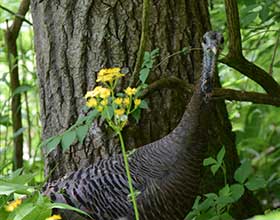 It’s November, and across the country, turkeys are arriving in grocery stores and home freezers. The great majority of those, of course, are domestic turkeys, raised on farms and bred for meat production. But wild turkeys are on the rise, too, and they’re quite a different beast.
It’s November, and across the country, turkeys are arriving in grocery stores and home freezers. The great majority of those, of course, are domestic turkeys, raised on farms and bred for meat production. But wild turkeys are on the rise, too, and they’re quite a different beast.
Wild turkeys are the largest North American upland game birds. In fact, male turkeys, which can weigh 10 kg (22 pounds) or more, are among the heaviest of all North American birds, rivaled only by some swans. Toms, as the males are known, are easy to recognize. Their large size, head ornamentation (red wattle hanging down from a bare, gnarly blue and red head), and glossy bronze feathers are distinctive. A strutting tom, with feathers fluffed, tail spread, and in full gobble, is a sight to behold. Females (hens), in contrast, are about half the size of males, don’t gobble, and lack a lot of the ornamentation. Still, their feathers have a beautiful iridescence, and a large female prowling the woods or fields can’t help but bring to mind a small dinosaur.
Although wild turkeys can be seen in open habitat, they are primarily creatures of forests and forest edges, which provide both food and secure hiding spots. Their preferred diet includes acorns and other nuts and seeds, though they are quite omnivorous and also will consume berries, fruits, and animals like insects or frogs.
Turkeys are members of the galliform order of birds, along with chickens, quails, pheasants, and others. Like many galliform birds, turkeys have high “wing loading,” meaning that they are heavy-bodied relative to the size of their wings. The corollary, of course, is that turkeys are built for walking, not flying. The leg muscles of galliform birds include a lot of red muscle fibers (“dark meat”), which supports the sustained, aerobic work of walking. In contrast, breast muscles (pectorals), which power flight, are mostly white muscle, structured to support intense, short-lived bursts of activity. As such, turkeys don’t migrate, and they typically fly for just short durations as they erupt from the ground after being disturbed. Nevertheless, those short bursts can take them aloft, and a mother hen with her chicks may well roost for the night high up in the branches of a large tree.
Mating activity—when males gather to strut their stuff to attract females–peaks for Ohio’s turkeys in mid-April. Males and females then part ways; males are not involved in parental duties. Hens lay up to a dozen or more eggs, which hatch in May or June after 28 days of incubation. The precocial chicks hatch with eyes open and ready to search for food, and they take their first flight in about two weeks. Those several weeks—nesting for the females, pre-flight for the juveniles—are times of high risk for mortality. As the chicks mature, the families wander in search of food. In the Centerville-Washington Township parks, sightings of females with young have become more common in recent summers, and family groups sometimes appear in the yards, or on the rooftops, of homes along woods edges. Turkeys remain in the area during the colder fall and winter months. However, they may shift locations as they search for good feeding grounds and shelter from wind and cold.
In the early 19th century, Ohio likely was home to more than a million turkeys, among the most of any state. Amazingly, though, that number declined to zero by about 1900, the result of habitat loss (deforestation) and unregulated hunting. In the 1950s, as Ohio’s forests were recovering, efforts were initiated to re-introduce turkeys to the state. Releases of captive-bred birds proved unsuccessful, but several hundred wild turkeys transplanted from eastern states to Ohio’s southeastern forests between 1956 and 1971 fared better. With turkey hunting having been banned, that population thrived and expanded to more than 7,500 birds by 1983, mostly still in the southeast quadrant of the state. Today, something like 175,000 turkeys inhabit all 88 of Ohio’s counties. Montgomery and Greene Counties, like much of west-central Ohio, remain on the low end of the population distribution.
Turkey hunting was reinstated in Ohio in the 1970s. On average, springtime hunters claimed more than 13,000 wild turkeys per year from 2020 – 2022, including 21 in Montgomery and 19 in Greene County. Numbers were higher in Spring, 2023, perhaps reflecting strong production of chicks in recent years. The fall hunting season is smaller, claiming about 1,000 birds in 2022, none in Greene or Montgomery County. Something like 90% of those hunted turkeys were male. That is partly compensated by differential mortality of males and females from other sources, but the Ohio wild turkey population is slightly more heavily female than would be the case without hunting.
The turkey is one of only two North American native birds to be domesticated, along with the Muscovy duck. At the same time, Ohio’s wild turkeys, like its white-tailed deer and bald eagles, now serve as examples of a highly successful conservation story. What a treat to come upon a turkey family on a park trail, or in the backyard. Let us be thankful for the resurgence of this splendid bird!
Article and photo contributed by Dr. David L. Goldstein, Emeritus Professor, Department of Biological Sciences, Wright State University.
